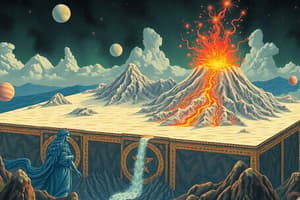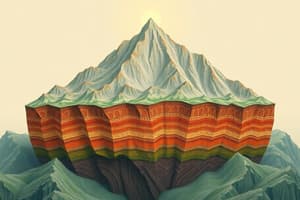Podcast
Questions and Answers
Which of the following types of plate boundaries is characterized by the creation of new oceanic crust?
Which of the following types of plate boundaries is characterized by the creation of new oceanic crust?
- Divergent (correct)
- Transform
- Convergent
- Conservative
What type of volcano is formed by alternating layers of lava and ash?
What type of volcano is formed by alternating layers of lava and ash?
- Cinder Cone
- Shield Volcano
- Composite Volcano (correct)
- Caldera
Which of the following is NOT a type of volcanic activity?
Which of the following is NOT a type of volcanic activity?
- Potentially Active
- Active
- Dormant
- Submerged (correct)
What is the relationship between magma's silica content and its viscosity?
What is the relationship between magma's silica content and its viscosity?
Which of the following is NOT evidence supporting the theory of plate tectonics?
Which of the following is NOT evidence supporting the theory of plate tectonics?
What is the significance of the occurrence of earthquakes and volcanoes along plate boundaries?
What is the significance of the occurrence of earthquakes and volcanoes along plate boundaries?
Which of the following scenarios is an example of a convergent plate boundary?
Which of the following scenarios is an example of a convergent plate boundary?
What is the primary force that drives volcanic eruptions?
What is the primary force that drives volcanic eruptions?
What is the primary difference between a phreatic and a phreatomagmatic eruption?
What is the primary difference between a phreatic and a phreatomagmatic eruption?
Which volcanic hazard is considered the most lethal and is characterized by a mixture of volcanic particles?
Which volcanic hazard is considered the most lethal and is characterized by a mixture of volcanic particles?
What is the primary climatic factor that contributes to the formation of a tropical climate?
What is the primary climatic factor that contributes to the formation of a tropical climate?
What is the primary difference between a constellation and an asterism?
What is the primary difference between a constellation and an asterism?
How do ocean currents influence climate?
How do ocean currents influence climate?
Which of the following is NOT a characteristic used to describe stars?
Which of the following is NOT a characteristic used to describe stars?
Which of the following is a key indicator of Global Climate Change?
Which of the following is a key indicator of Global Climate Change?
What is the primary difference between El Niño and La Niña?
What is the primary difference between El Niño and La Niña?
What celestial object is NOT a constellation or asterism but serves as an important navigation tool?
What celestial object is NOT a constellation or asterism but serves as an important navigation tool?
Why do we see different constellations at different times of the year?
Why do we see different constellations at different times of the year?
Which of the following is NOT a practical way to mitigate the impacts of climate change?
Which of the following is NOT a practical way to mitigate the impacts of climate change?
What is the primary component of a galaxy, besides stars?
What is the primary component of a galaxy, besides stars?
What is the main driving force behind the Strombolian type of volcanic eruption?
What is the main driving force behind the Strombolian type of volcanic eruption?
Which of the following is NOT a component of a galaxy?
Which of the following is NOT a component of a galaxy?
What is the significance of the Balatik constellation in tribal culture?
What is the significance of the Balatik constellation in tribal culture?
Which of the following is NOT a measure or characteristic of a star?
Which of the following is NOT a measure or characteristic of a star?
Flashcards
Plate Tectonics Theory
Plate Tectonics Theory
The theory that Earth's lithosphere is divided into plates that move.
Evidence of Plate Tectonics
Evidence of Plate Tectonics
Fossils, earthquake locations, geological features, and seafloor spreading support this theory.
Plate Boundaries
Plate Boundaries
Regions where tectonic plates interact; types include convergent, divergent, and transform boundaries.
Convergent Boundaries
Convergent Boundaries
Signup and view all the flashcards
Divergent Boundaries
Divergent Boundaries
Signup and view all the flashcards
Cinder Cone Volcano
Cinder Cone Volcano
Signup and view all the flashcards
Active Volcano
Active Volcano
Signup and view all the flashcards
volcanic eruption factors
volcanic eruption factors
Signup and view all the flashcards
Phreatic Eruption
Phreatic Eruption
Signup and view all the flashcards
Plinian Eruption
Plinian Eruption
Signup and view all the flashcards
Pyroclastic Density Currents
Pyroclastic Density Currents
Signup and view all the flashcards
Global Warming
Global Warming
Signup and view all the flashcards
El Niño
El Niño
Signup and view all the flashcards
La Niña
La Niña
Signup and view all the flashcards
Factors Affecting Climate
Factors Affecting Climate
Signup and view all the flashcards
Mitigating Climate Change
Mitigating Climate Change
Signup and view all the flashcards
Color and Temperature of Stars
Color and Temperature of Stars
Signup and view all the flashcards
Apparent Brightness
Apparent Brightness
Signup and view all the flashcards
Absolute Brightness
Absolute Brightness
Signup and view all the flashcards
Constellation
Constellation
Signup and view all the flashcards
Asterism
Asterism
Signup and view all the flashcards
Circumpolar Constellations
Circumpolar Constellations
Signup and view all the flashcards
Astrology
Astrology
Signup and view all the flashcards
Polaris
Polaris
Signup and view all the flashcards
Study Notes
Earth and Space Science
- Plate Tectonics Theory: Proposes the Earth's lithosphere is composed of plates.
- Evidence Supporting Plate Tectonics:
- Fossil distribution: Similar fossils found in different locations.
- Earthquake and volcano locations: Clustered at plate boundaries.
- Geological Features: Activities occur along boundaries.
- Spreading seafloor: Molten material causes plates to move apart.
- Plate Boundaries: These are locations where plate interactions cause geological activity.
- Convergent Boundaries: Plates move toward each other.
- Types include fold mountains, deep-sea trenches and volcanic mountains.
- Resulting movement is destructive.
- Continental-Continental: Neither plate sinks.
- Continental-Oceanic and Oceanic-Oceanic: Denser oceanic plate sinks.
- Divergent Boundaries: Plates move away from each other.
- Types include mid-ocean ridges and rift valleys
- Resulting movement is constructive.
- Transform Boundaries: Plates slide past each other.
- Types include major earthquakes.
- Resulting movement is conservative.
- Volcanoes:
- Types (Structure):
- Cinder Cone (e.g., Taal) – Piles of lava
- Composite/Stratovolcano (e.g., Mayon) – Alternating layers of lava and ash.
- Shield (e.g., Mauna Kea) – Outpourings of lava
- Types (Activity):
- Active – Erupted within last 10,000 years.
- Potentially-Active – Young looking, no recent eruption records
- Inactive – Not erupted in last 10,000 years.
- Types (Structure):
- Volcanic Eruptions: Magma's temperature, viscosity, silica content, amount of dissolved gases are factors that affect eruptions.
- Types: Phreatic, Phreatomagmatic, Strombolian, Vulcanian, Plinian
- Volcanic Hazards: Lava flows, tephra falls, pyroclastic density currents (PDCs).
- Energy from Volcanoes: Hot water from volcanic activity can be converted to steam to generate electricity.
- Climate Factors: Latitude, altitude, distance from sea, topography regulate climate.
- Climate Phenomena: Global Warming, El Niño, La Niña.
- Indicators of Climate Change: Rising temperatures, sea levels, melting ice caps.
- Practical Ways to Mitigate Climate Change: Reduce, reuse, recycle, eat vegetables, save energy.
- Stars and Constellations:
- Stars are massive balls of gas (Hydrogen and Helium).
- Movement of Stars: Earth's rotation and revolution affect star visibility.
- Beliefs and Practices about Constellations: Astrology and Indigenous practices like using constellations for navigation.
- Galaxies: Composed of Hydrogen, Helium, oxygen and Carbon.
- Types: Spiral, Elliptical and Irregular.
- Components: Disk, bulge.
Studying That Suits You
Use AI to generate personalized quizzes and flashcards to suit your learning preferences.




